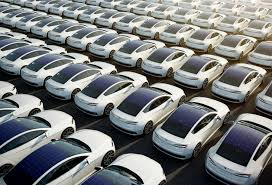As the world races towards a sustainable future, the automotive industry is undergoing a transformative shift. An exciting development is the integration of solar power into electric vehicles (EVs), led by innovators like Tesla and Rivian. According to a recent report by Bloomberg Green, the adoption of renewable energy sources in transportation could reduce global CO2 emissions by nearly 25%. In this article, we’ll explore how these trailblazing companies are pioneering solar-powered electric vehicles, discuss their groundbreaking technologies, and offer practical advice for consumers interested in this green revolution.
Tesla’s Solar Integration: Leading the Charge
Tesla’s Solar Roof and Powerwall
Tesla is not just an automotive brand; it’s an energy company at its core. The company has been revolutionizing how we think about energy consumption with its Solar Roof and Powerwall technologies. These systems are designed to capture solar energy, store it, and use it to power homes and Tesla vehicles alike.
- Solar Roof: With aesthetics that mimic traditional roofing materials, Tesla’s Solar Roof is designed for seamless integration into homes. This innovation allows homeowners to harness solar energy efficiently, contributing to a sustainable lifestyle.
- Powerwall: Tesla’s Powerwall is a home battery system that stores solar energy for use at night or during power outages. It provides a reliable source of energy that can also be used to charge Tesla vehicles.
Solar Charging for EVs
Tesla has also explored solar charging options for its vehicles. While direct solar charging is still in the experimental stage, Tesla’s extensive Supercharger network is increasingly being powered by solar energy. This not only reduces the carbon footprint of charging facilities but also makes EV ownership more sustainable.
Rivian’s Adventurous Approach to Solar Power
Adventure Network with Solar Charging
Rivian, known for its rugged electric trucks and SUVs, is taking a unique approach by focusing on off-grid solar charging solutions. The company’s Adventure Network is set to feature charging stations powered by renewable energy sources, including solar power, in remote and outdoor locations.
- Remote Charging Stations: Rivian plans to install solar-powered charging stations in national parks and adventure destinations, making it easier for drivers to explore nature sustainably.
- Portable Solar Kits: To further cater to the adventurous spirit, Rivian offers portable solar charging kits that allow users to charge their vehicles in off-grid locations.
The R1T and R1S Models
Rivian’s R1T (pickup truck) and R1S (SUV) are designed with sustainability and adventure in mind. These vehicles are equipped with features that support solar integration, such as roof racks designed to accommodate solar panels, making them ideal for eco-conscious adventurers.
The Impact of Solar-Powered EVs
Environmental Benefits
Solar-powered EVs offer numerous environmental benefits, including:
- Reduced Carbon Footprint: By using solar energy, these vehicles minimize dependence on fossil fuels, significantly reducing greenhouse gas emissions.
- Sustainable Energy Consumption: Solar energy is renewable and abundant, making it a sustainable choice for powering EVs.
- Energy Independence: Solar-powered vehicles can be charged off-grid, reducing reliance on traditional energy sources.
Economic Advantages
- Lower Operating Costs: Solar energy is free, reducing the cost of charging EVs over time.
- Incentives and Rebates: Governments worldwide offer incentives for solar energy adoption, making solar-powered EVs more affordable.
- Increased Property Value: Homes equipped with solar charging infrastructure may see an increase in property value, providing financial benefits to owners.
Practical Tips for Embracing Solar-Powered EVs
How to Charge Your Solar-Powered EV
- Install Solar Panels at Home: Consider installing solar panels and a storage system, like Tesla’s Powerwall, to charge your EV sustainably.
- Use Solar Charging Networks: Take advantage of solar-powered charging networks, such as Tesla’s Supercharger and Rivian’s Adventure Network, when available.
Where to Buy Solar-Powered EVs
- Tesla: Visit Tesla’s official website or showrooms to explore their range of EVs and solar products.
- Rivian: Explore Rivian’s vehicles and solar solutions through their website or by contacting their sales team.
What to Compare When Choosing
- Vehicle Range: Compare the range of different models to ensure they meet your driving needs.
- Solar Integration Features: Assess the ease of integrating solar charging solutions with each vehicle.
- Cost and Incentives: Consider the overall cost, including any available government incentives for solar energy adoption.
Conclusion: Driving Towards a Solar-Powered Future
Tesla and Rivian are at the forefront of a solar-powered revolution in the automotive industry. By integrating solar energy into their vehicles and infrastructure, they are not only reducing carbon footprints but also making sustainable transportation accessible to a broader audience. As solar technology continues to evolve, we can expect even more exciting innovations in the coming years.
Are you ready to join the solar-powered EV movement? Whether you’re a nature enthusiast or simply looking to reduce your environmental impact, these pioneering technologies offer a glimpse into a cleaner, greener future. Share your thoughts on how solar power could change the way we drive, and stay tuned as we continue to explore the future of electric mobility.

